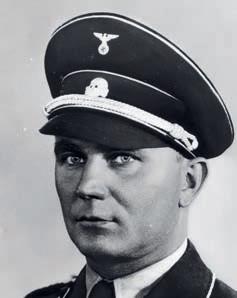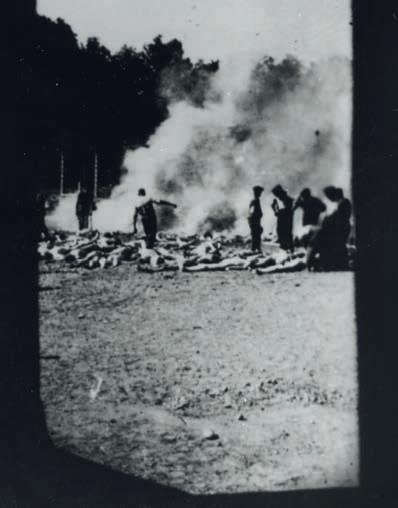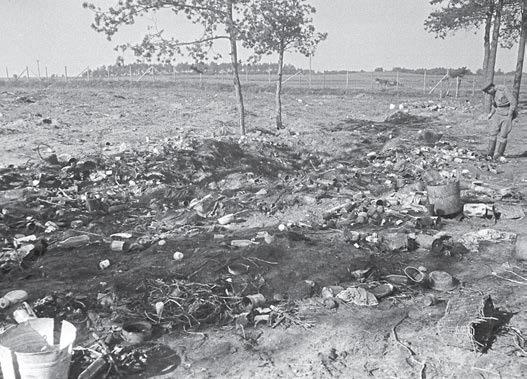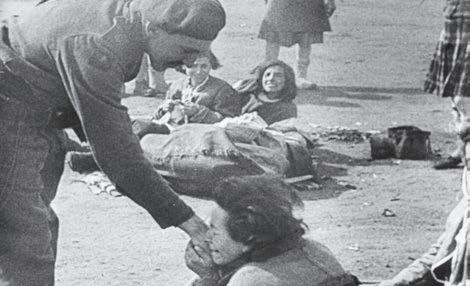
16 minute read
4.4 What was the ‘Final Solution’?
4.4 What was the ‘Final Solution’?
For the Nazis, victory in Eastern Europe would create an opportunity for them to ‘solve’ things that they wrongly believed were problems. In the Nazis’ racist worldview, one of the main ‘problems’ was what to do with the Jewish people who were under their control. However, even among Nazis there were different views over what to do. All believed a ‘final solution’ to the Jewish ‘problem’ was needed.
Murder moves westwards
Herbert Lange
Herbert Lange was a policeman who joined the Nazi Party in 1932 and the SS in 1933. In 1939–40, Lange was in charge of a group that murdered people who were classified by the Nazis as ‘disabled’ in the Warthegau – an area of Germanoccupied Poland. The group came up with the idea of gassing these people in converted vans.
Activities
1 Why did Greiser decide to murder
Jews in the Warthegau? 2 What can we learn about the decision-making process behind the Holocaust from the events in the Warthegau?
Arthur Greiser
Arthur Greiser was governor of the Warthegau. Greiser wanted to make the Warthegau free of Jews, most of whom were now living in ghettos. He tried and failed to do this by moving Jews into other parts of German-occupied Poland. Eventually, he decided to achieve his goal through murder. In the summer of 1941, once Hitler and Himmler had given their permission, Greiser and his officials began drawing up plans. Mass shootings began in September, but a new method of killing was introduced. In 1939 and 1940, gas vans had been used to kill thousands who were classified by the Nazis as ‘disabled’ in Germany and German-occupied Poland. It was decided this would be the best way to make the Warthegau ‘free’ from Jews.
UNIT 4
Europe’s Jews in the Second World War
Chelmno

In the autumn of 1941, Herbert Lange was given the job of killing those Jews in the Warthegau who could not be used as slave labour. He chose Chelmno, a small village of around 250 people, as the site for a new camp (see Figure 4.10) based in a mansion in the middle of the village. On 8 December, a group of nearby Jews were rounded up and driven to the mansion. They were told they were being sent for work, but needed to shower. They undressed, left their valuables and were then guided into the back of a van. The doors closed and gassing began. After around ten minutes, the van drove to a forest where the bodies were buried or burnt.
Small groups of men were kept alive to do work, including taking victims to the gas vans, cleaning the vans and sorting through possessions. When not working, they would be kept locked in a room in the basement (see Figure 4.11). Periodically, these men would themselves be killed.
Figure 4.10 View of the village of Chelmno, taken sometime between 1939 and 1943. The mansion is visible on the left of the photograph (next to the church and its spire).

Figure 4.11 A group of Jewish men, likely to be members of a labour squad, at the mansion in Chelmno, sometime between 1941 and 1943.
By the time the Germans left Chelmno in January 1945, at least 172,000 Jewish people had been killed there. Many came from the Łód´z ghetto.
Simon Srebrnik
Simon was deported to Chelmno from the Łód´z ghetto when he was 13 years old. He was put in chains and selected to sort clothes and valuables, burn bodies and take the ashes of victims in a boat and dump them down river. Simon was well known by people living in Chelmno. In January 1945, he managed to escape. 4.4 What was the ‘Final Solution’?

Activities
1 Who developed the method of mass murder used at Chelmno? 2 How was the murder of Jews at
Chelmno connected to the murder of another victim group?
Source 4.3
There were many handbags, a mountain of handbags. Once, I found a handbag with my mother’s pictures and all her documents. From the testimony of Simon Srebrnik
Think about
Do you think that the people of Chelmno knew what was happening at the death camp?
The death camps
Chelmno was the first death camp in history. Its sole purpose was to murder. Even those who were kept alive for slave labour would be killed eventually. This was the underlying idea of a death camp. No one was meant to survive. Chelmno began because of the ambitions of Arthur Greiser. But by the time Chelmno opened, the idea of murdering Jews was widely accepted among the Nazi leadership. We do not know when exactly, and no written order exists, but by the winter of 1941, decisions had been made to co-ordinate the killing already taking place in the Warthegau and the Soviet Union and to include Jews living in Western Europe. In 1942, other death camps opened in German-occupied Poland (see Figure 4.12). Located close to major train routes to make them accessible, these camps were often in quite remote areas. However, those who lived nearby knew what happened there and rumours soon spread across Europe. Like Chelmno, murder was by gas, but not in vans: instead, people were killed in specially built chambers either by the fumes of engines or – as at Auschwitz-Birkenau – by poison gas.
UNIT 4
N Europe’s Jews in the Second World War
Tallinn
London
Paris
Bergen-Belsen
Buchenwald
Dachau
Berlin Chelmno
Prague
Auschwitz-Birkenau
Vienna Treblinka
Warsaw
Sobibor Majdanek
Belzec
Budapest
Bucharest
0 250 km
Leningrad
Babi Yar 4.4 What was the ‘Final Solution’?
Moscow Key
Death camps
Main concentration camps Sub camps Ghettos
Major cities
Mass murder sites June 1941–Nov. 1942
Nazi controlled land
Allied powers Neutral nations
The six main death camps in Nazi-occupied Poland
Chelmno
Operational: December 1941–March 1943/ April–July 1944 c. 172,000 victims
Belzec
Operational: March–December 1942 434,500 victims
Auschwitz-Birkenau
Operational: Spring 1942–January 1945 1,100,000 victims
Sobibor
Operational: May 1942–November 1943 170,000–250,000 victims
Treblinka
Operational: July 1942–September 1943 870,000 victims
Majdanek
Operational: October 1942–December 1943 78,000 victims
Figure 4.12 Spaces of Nazi persecution and murder.
Think about
Study Figure 4.12. What does the map tell us about the geography of the Holocaust? What questions does it raise?
UNIT 4
Europe’s Jews in the Second World War
The Wannsee Conference
By the end of 1941, hundreds of thousands of Jewish people in Eastern Europe had been killed. Murder had started to move westwards (see page 55), while Nazi leaders were worried that the war against the Soviet Union was not going well. At some point in the last few months of 1941, it was decided that the ‘Final Solution’ to the ‘Jewish problem’ was mass murder. Genocide would now be pursued across Europe. On 20 January 1942, fifteen leading Nazis and German officials met at a villa near Berlin. The Wannsee Conference was a meeting to discuss how different government departments would work together to deport Jewish people from across Europe and take them to the death camps. The meeting was led by Heydrich, who emphasised that the SS would be in charge and demanded everyone’s cooperation. An intense wave of murder followed. Over the next 12 months, millions were killed. In Nazioccupied Poland alone, for instance, 1.2 million Jews were murdered in a programme codenamed Operation Reinhard.
Activities
1 What was the purpose of the
Wannsee Conference? 2 What was different about death camps, compared to the ‘Holocaust by bullets’? Think about
On 20 July 1944, Jewish people living on the Greek islands of Rhodes and Kos were put on a boat to the mainland. From there, they travelled for nearly two weeks by train to AuschwitzBirkenau. How many countries did these people pass through? What does this tell us about the Nazi plan to destroy Jewish life across Europe?
Deportation
With the decision to murder as many European Jews as possible, a process of deportation began. People living in ghettos started to be sent to the death camps, where they were to be joined by Jews from across Europe. Transporting Jews from all corners of the continent was a massive undertaking. With local cooperation, Jews were rounded up, placed on trucks, trains and boats, and sent to the camps in the East. The journeys were often very long and conditions were appalling. Many died during the journey.

Figure 4.13 Jews boarding a train to the East at Westerbork, in the Netherlands.
4.4 What was the ‘Final Solution’?
Auschwitz-Birkenau
Activity
What do you know about ‘Auschwitz’? Work with a partner and compile a list of all you know.
1940
The Nazis change the name of Oświęcim in Poland to ‘Auschwitz’. The SS convert some existing army barracks into a concentration camp for Polish political prisoners. This becomes ‘Auschwitz I’ (the camp with the brick buildings you can see today).
New camps and sub-camps are built in and near the town, each with a different purpose. One, intended for Soviet prisoners of war, is called Auschwitz-Birkenau. Building work begins in October 1941. By early 1942, plans had changed; it was to become a death camp for Jews and others.
In spring 1942, a farmhouse is converted to a gas chamber. By summer, another larger gas chamber opens in another former farmhouse. In these buildings, thousands were killed by the Nazis and their collaborators but they could not cope with the number of people being sent to them.
In February 1943 thousands of Roma are deported to Auschwitz-Birkenau. They are placed in a so-called ‘Gypsy Family Camp’. Around 22,000 people are imprisoned here before it is closed in August 1943. Thousands die from disease or are killed in the gas chambers.
By March 1943, four new buildings open, each containing a gas chamber and crematoria ovens for burning bodies. By summer 1943, it was now possible for around 150,000 people to be killed each month at Auschwitz-Birkenau.
Figure 4.14 SS photograph of cement being poured during the construction of Crematorium III at Auschwitz-Birkenau, 1942–43.

The majority of Europe’s Jews were murdered between March 1942 and February 1943. Death mainly came at the hands of the Einsatzgruppen, from starvation and disease in ghettos, or by gas in the death camps. By the summer of 1943, the deadliest place for Jews in Europe was Treblinka. There, around 700,000 people had been murdered since July 1942. In 1944, this changed when the death camp at Auschwitz-Birkenau became the destination of the largest remaining Jewish community in Europe: the Jews of Hungary.
Activity
Return to your list of things you know about ‘Auschwitz’. Do you need to revise any of these ideas? What new information can you add?
UNIT 4
Europe’s Jews in the Second World War
Case study: Hungary, 1944
In March 1944, Germany invaded Hungary to stop it from making peace with the Allied powers. Under Nazi pressure, a new government took over and it was committed to deporting the Jews. Very quickly, Hungarian Jews were put into ghettos. In May, these began to be emptied and Jewish men, women and children were put on trains headed for Auschwitz-Birkenau. In a matter of six weeks, 430,000 people had arrived at the death camp. The camp struggled to cope. The gas chambers and crematoria worked through the night. Bodies were burned in the open. A new railway spur was built so that trains could take Jews directly to the gas chambers. By the time the Soviet army liberated Budapest in January 1945, around 565,000 Hungarian Jews had been murdered.
Activities
Look at the photograph taken at Auschwitz-Birkenau in 1944 (Figure 4.15) and Eva’s diary entry. 1 What is the value of the photograph?
Why is it significant? What questions does it raise? 2 Did Eva believe what she and her grandparents were told about being resettled? What does her diary reveal about how much people knew and understood in 1944?
Figure 4.15 Bodies being burnt in the open at Auschwitz-Birkenau, August 1944. This photograph was taken in secret by a Jewish man forced to work in the gas chamber. The camera was smuggled into the camp by the Polish resistance movement. The photograph is one of the few we have of the killing process at Auschwitz-Birkenau. The victims are believed to be Hungarian Jews.

Eva Heymann
On 13 February 1944, 13-year-old Eva started writing a diary. She was living in Nagyvárad, Hungary, with her grandparents following her parents’ divorce. Her dream was to be a newspaper photographer. Eva and her grandparents were forced into the city’s ghetto in April 1944. On 29 May, they were told they were going to be ‘resettled in the East’. Eva made her last diary entry the next day: ‘… Dear diary, I don’t want to die; I want to live even if it means that I’ll be the only person allowed here to stay […] I can’t write anymore, dear diary, the tears run from my eyes’. A few days later, Eva and her grandparents were taken to Auschwitz-Birkenau, where they were murdered on 17 October 1944.
4.5 When and how did the Holocaust end?
4.5 When and how did the Holocaust end?
The Holocaust only ended with the defeat of Nazi Germany. From the summer of 1944, the wartime Allied powers, the Soviet Union in the east and Britain and the USA in the west and the south, forced the German army to retreat after a series of defeats.
The death marches
As the German army retreated, those prisoners still alive in the remaining camps began to be moved away from the approaching Allied forces to other concentration camps, work camps and their sub camps inside Germany and Austria. The Nazis wanted to make sure there were no witnesses to their crimes. Also, they still wanted to use Jewish prisoners as slave labour.
Prisoners were either forced to walk, often for weeks at a time, or were herded into tightly packed freight trains, made for goods not people. There was no shelter and they were given little, if any, food and water. Those prisoners who could not keep up or who tried to escape were shot. Conditions on these forced marches were so terrible that the prisoners themselves gave them the name ‘death marches’. In total, approximately 250,000 prisoners, both Jews and non-Jews, died as a result of the death marches.
Think about
What do Figure 4.16 and Source 4.5 on the next page tell us about what German civilians knew and how they treated prisoners? Why might some German civilians have taken such photographs in secret?

Figure 4.16 Death march from Dachau. German civilians secretly photographed several death marches as they passed through their towns.
UNIT 4
Europe’s Jews in the Second World War
Source 4.4
For nine days I had been walking completely barefoot in the snow … The transport commander selected all the bare-footed and put them in the carts with the sick. Calmly he told us that we would be shot within half an hour … We were not shot … We were put into open cattle cars for three days and three nights … On the way, 75 per cent of us were frozen. From the testimony of Elisabeth Herz Source 4.5
The area was German, and the local Hitler Youth groups threw stones at them [the prisoners] … as they passed through the townships. The German peasants refused to lodge them [the prisoners] in stables. They are afraid of the ‘Jewish devils’; the girls had to sleep in the field, in the snow. In Christianstadt German women tried to give us bread. But the women guards wouldn’t permit it … The brutal woman guard yelled: ‘What are you doing, pitying Jews?’
From the testimony of Aliza (Frunka) Besser
Liberation
As they advanced towards Germany, the Allied forces found victims of the death marches. They also found death camps, concentration camps and work camps. Soldiers were horrified by what they found. Because of starvation, disease and brutal treatment, the few surviving prisoners were very close to death. Evidence of mass murder and torture was there for the world to see. On 7 May 1945, the Germans surrendered to the British and Americans. Two days later, on 9 May 1945, Germany surrendered to the Soviets. The Second World War in Europe was over. For the few prisoners left alive in the camps, this meant freedom and the chance of survival. Yet for many, liberation came too late. Weak from starvation, disease, torture and forced labour, liberated prisoners continued to die.
Treblinka
The Nazis had destroyed the death camps at Treblinka, Sobibor and Belzec in 1943. This was because they had completed their task in murdering the majority of Poland’s Jews. Soviet troops reached the site of Treblinka during the last week of July 1944. A farmhouse was now built on the site and the ground was ploughed. Despite the Nazis’ attempts to hide the mass murder that took place there, the Soviets found small pieces of bone, human teeth and the belongings of those murdered.

A Soviet soldier (on the right) stands next to evidence of mass murder at the site of the Treblinka death camp.
4.5 When and how did the Holocaust end?
Auschwitz-Birkenau
Attempts to hide evidence of mass murder increased as Germany began to lose the war and retreat. At the end of October 1944, the gas chambers at Auschwitz-Birkenau were closed, and in November Himmler ordered their destruction. The chaos of this time meant that in some places evidence wasn’t destroyed and the ruins of gas chambers remained at some camps but not at others. On 27 January 1945, the Soviets liberated Auschwitz-Birkenau and the 7,000 prisoners who remained alive there.

The ruins of crematorium and gas chamber II at Auschwitz-Birkenau. The image shows the entrance to the changing room.
Bergen-Belsen
On 15 April 1945, the British liberated BergenBelsen concentration camp. Sixty thousand emaciated and sick prisoners were in desperate need of medical attention. More than 13,000 dead prisoners lay unburied around the camp, victims of starvation, disease and Nazi brutality. Roughly two-thirds of those found alive were Jewish. Many of these were survivors of forced death marches from death camps in the East, especially Auschwitz-Birkenau.

A woman inmate of Bergen-Belsen concentration camp kisses the hand of Army Film & Photographic Unit cameraman Lieutenant Martyn Wilson on liberation.
Dachau
On 27 April 1945, as American troops approached the area around Dachau concentration camp, 7,000 prisoners, mostly Jews, were forced to begin a death march away from the camp. Just two days later, on 29 April 1945, after a brief battle with the remaining SS guards, the camp was liberated by the Americans. They discovered 30,000 survivors, most severely emaciated. There were also 9,000 dead prisoners found at the camp.

Prisoners liberated by the Americans inside Dachau concentration camp.
Now you have studied this unit, check your knowledge here: www.ucl.ac.uk/holocaust-education








